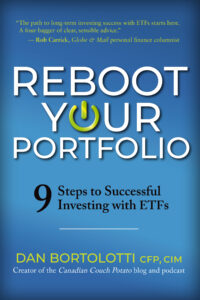New investors—especially if they’re young—may be especially prone to this mistake, but it’s not all their fault. The conventional advice is that young people should be aggressive. After all, they have time on their side. It’s very unusual for stocks to deliver a negative return over any 10-year period, so if your time horizon is 50 or 60 years or more, why not put 100% of your savings in stocks? That argument has some merit, and if you truly understand all the implications of making that decision, then sure, go ahead and build an all-equity portfolio. But I don’t think any inexperienced investor should do this. As a newbie, you’re like a fighter pilot who has only been in a flight simulator and has never flown in combat. You really don’t know how you’re going to hold up until you’ve been battle-tested.
If you’re going to invest virtually all of your portfolio in stocks, you need to be prepared for the possibility that you could lose half your money—even if you’re holding broadly diversified index funds. In 2008–09, we had a 50% decline in about six months, and it could happen again. Yes, if you’re in your teens or 20s, you have the time horizon and earning potential to make up a loss like that. But try telling that to a student who worked for three summers to earn the $5,000 they just lost, or a young professional who just vaporized a dozen paycheques.
The danger here is that investors who get badly burned when they’re young may be scared out of the market for years—maybe forever. There’s evidence that this happened with millennials who were slammed by the 2008–09 financial crisis and lost their faith in equities as long-term investments. It might have happened again following the crash of 2020 if markets hadn’t recovered so quickly.
There’s another issue to consider if you’re a new investor contemplating a very aggressive portfolio. When your account is still relatively small, your rate of return doesn’t have much of an impact in dollar terms. Say you’re starting out with $10,000. If you have a great year and earn 10% in an all-equity portfolio, you’ll make $1,000. If you instead earn 4% with a balanced portfolio, you’ll make $400. Obviously over the long term, the difference between 10% and 4% returns is absolutely enormous. But right now, with a small portfolio, it’s a few hundred bucks a year, and it comes with all the risk we’ve just discussed. I’m not sure it’s worth it. At this stage of your investing life, you’re more likely to regret being too aggressive than being too conservative.
Here’s what I suggest for young people building their first ETF portfolio. Start off with a balanced allocation—about 50% or 60% stocks is about right. Get your feet wet for a couple of years and see how you react to the ups and downs in the market. Find out what kind of investor you really are. Do you check your account balance every day and feel stressed when it’s below its peak? If the markets tank, is your instinct to sell, or do you get excited about buying on the cheap?

The big test will come during the next bear market: if and when you lose 20% or 30% and it doesn’t faze you, then you can consider making your portfolio more aggressive in the future. Until then, stay focused on saving: that habit will have the biggest impact on your financial success.
Dan Bortolotti, CFP, CIM, is a portfolio manager with PWL Capital in Toronto. He works with clients to combine investment management with long-term financial planning. He also promotes investor education through his blog, articles and podcast.
This article was excerpted from Reboot Your Portfolio: 9 Steps to Successful Investing with ETFs.













